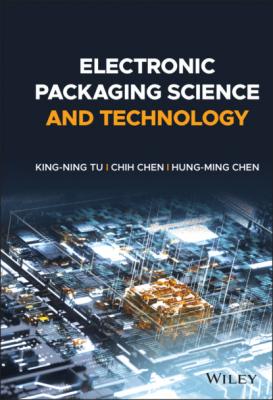Electronic Packaging Science and Technology. King-Ning Tu
Читать онлайн.| Название | Electronic Packaging Science and Technology |
|---|---|
| Автор произведения | King-Ning Tu |
| Жанр | Химия |
| Серия | |
| Издательство | Химия |
| Год выпуска | 0 |
| isbn | 9781119418337 |
Figure 1.7 An example of electromigration electromigration‐induced failure of void formation in Cu interconnects. (a) Electrons drifted from the bottom Cu line to the top Cu line. (b) Electrons drifted from the top Cu line to the bottom Cu line.
1.6 The Future of Electronic Packaging Technology
In the near future, the R&D of packaging technology for 3D IC devices will be the focus. The role of electronic packaging in Si‐based microelectronic technology is getting more and more important. In turn, reliability will be of major concern. The introduction of AI to facilitate the applications to new 3D IC devices and the reduction of the time‐consuming reliability tests will demand our concentrated effort. In the long run, the applications of electronic packaging technology to biomedical devices will be important. For example, as people lives longer, diabetes is common in old age. To determine oxygen content and sugar content in our blood, we use invasive method to obtain a drop of blood from our finger for measurement. It is very unpleasant! If we can invent a noninvasive method, for example by wearing a mobile device around our finger or arm, it will greatly reduce the unpleasant feeling in our daily live if we have diabetes. Even better, if we can implant a small device in our body to perform the blood testing function, we will need to understand the interfacial interaction between biological and nonbiological materials. In other words, we will need to study bio‐compactable materials, as well as the chemical reactions in body fluid at body temperature. Furthermore, we may need to join a biomaterial to a non‐biomaterial. To do so, we may need a low‐temperature solder or binder which can decompose slowly in the body. However, the melting point of the common Pb‐free solder, the eutectic SnAg, is over 200 °C, to be discussed in Chapter 4 on solder joint reactions. We may need a new solder whose wetting temperature is around 100 °C, which is above the working temperature and near the body temperature, for biomedical devices. While these issues are beyond the scope of this book, we note that the future of electronic packaging technology has a long way to go.
1.7 Outline of the Book
The following chapters will be divided into three parts. In Part I, we cover briefly the history of bonding technology in Chapter 2, starting from wire‐bonding, tab‐automated bonding (TAB), flip chip C‐4 solder joint bonding, micro‐bump bonding, Cu‐to‐Cu direct bonding, and hybrid bonding. In Chapter 3, we shall cover the structure, properties, and applications of randomly oriented and (111) unidirectionally oriented nano‐twin Cu. Then, Chapters 4 and 5 will be dedicated to chemical reactions and kinetic processes in solder joint formation. Chapter 4 will review solid–liquid interfacial diffusion (SLID) reactions between liquid solder and Cu. Chapter 5 will review solid–solid reactions between solid solder and Cu upon annealing. The kinetics of growth of IMC, which is a stoichiometric compound without composition gradient, has been an outstanding problem in the kinetic analysis of layered interfacial reactions. We introduce Wagner’s diffusivity to overcome it.
Part II consists of three chapters related to electric circuitry in electronic packaging. The emphasis is about the design of low‐power devices and high intelligent integration. The technical issues of the need of faster rate and larger amount of data transport are discussed. How to increase the I/O density and the bandwidth in packaging technology are explained.
Part III is a collection of chapters on reliability science. It begins with a chapter on irreversible processes of atomic flow, heat flow, and charge flow in interconnects. The topics of electromigration, thermomigration, stress migration, and failure analysis will be covered. The topic of men‐time‐to‐failure (MTTF) will be reviewed on the basis of entropy production.
In the last chapter, Chapter 14, a discussion on how to use AI to accelerate the solving of reliability problems will be explored. We propose an X‐ray‐based graphic processing unit (X‐GPU) to analyze reliability failure distribution in any newly developed 3D IC device for mass production. The goal is to change the time‐dependent and time‐consuming reliability tests to time‐independent tests.
References
1 1 Chen, K.‐N. and Tu, K.N. (2015). Materials challenges in three‐dimensional integrated circuits. MRS Bulletin 40: 219–222.
2 2 Iyer, S. (2015). Three‐dimensional integration: an industry perspective. MRS Bulletin 40: 225–232.
3 3 Chen, C., Yu, D., and Chen, K.‐N. (2015). Vertical interconnects of microbumps in 3D integration. MRS Bulletin 40: 257–263.
4 4 Prigogine, I. (1967). Introduction to Thermodynamics of Irreversible Processes, 3e. New York: Wiley‐Interscience.
5 5 Tu, K.N. (2011). Chapter 10 on “Irreversible processes in interconnect and packaging technology”. In: Electronic Thin‐Film Reliability (ed. K.N. Tu). Cambridge, UK: Cambridge University Press.
6 6 Tu, K.N., Liu, Y., and Li, M. (2017). Effect of Joule heating and current crowding on electromigration in mobile technology. Applied Physics Reviews 4: 011101.
7 7 Tu, K.N. and Gusak, A.M. (2019). A unified model of mean‐time‐to‐failure for electromigration, thermomigration, and stress‐migration based on entropy production. Journal of Applied Physics 126: 075109.
Конец ознакомительного фрагмента.
Текст предоставлен ООО «ЛитРес».
Прочитайте эту книгу целиком, купив полную легальную версию на ЛитРес.
Безопасно оплатить книгу можно банковской картой Visa, MasterCard, Maestro, со счета мобильного телефона, с платежного терминала, в салоне МТС или Связной, через PayPal, WebMoney, Яндекс.Деньги, QIWI Кошелек, бонусными картами или другим удобным Вам способом.
